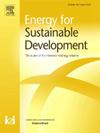基于参数化和多标准决策(MCDM)的城市光伏潜力评估:案例研究和新的方法论
IF 4.4
2区 工程技术
Q2 ENERGY & FUELS
引用次数: 0
摘要
作为一种重要的绿色能源生产技术,光伏发电可应用于各种城市场景,以减少环境污染,促进能源转型和可持续发展。本文将参数化方法和多标准决策(MCDM)引入城市光伏潜力评估,以提高评估的准确性。案例研究选取了中国山西省太原市杏花岭区。构建的组合分析方法支持评估过程的关键阶段,包括土地分类、光伏可用面积计算和光伏技术优化部署。利用参数化方法计算地块的太阳辐射接收能力,并利用层次分析法(AHP)计算发电量、经济成本、环境影响和美观四个光伏标准的权重。通过 TOPSIS 方法确定最佳光伏部署方案。评估结果表明,杏花岭区的光伏发电潜力为 2790.5GWh/年,其中发电潜力最大的地块类型为多层住宅,达到 635.9GWh/年。高层建筑的光伏发电潜力主要体现在外立面上。该地区光伏发电潜力最大的区域位于西南部,建筑密集,功能复杂。案例研究中提出的方法考虑到了不同地块和建筑外墙对光伏发电部署的不同要求,提高了评估的准确性。该研究为建立一个广为接受、可推广的城市光伏潜力精确预测模型提供了方法和理论支持。本文章由计算机程序翻译,如有差异,请以英文原文为准。
Assessment of the photovoltaic potential at urban level based on parameterization and multi criteria decision-making (MCDM): A case study and new methodological approach
As an important technology for producing green energy, photovoltaic(PV) power generation can be deployed in various urban scenarios to reduce environmental pollution and promote energy transformation and sustainable development. In this paper, parametric method and multi-criteria decision making (MCDM) are introduced into urban PV potential assessment to improve the accuracy of the assessment. Xinghualing District, Taiyuan City, Shanxi Province, China was selected for the case study. The constructed combination analysis method supports the key phases of the assessment process, including land classification, PV available area calculation and PV technology optimization deployment. The solar radiation receiving capacity of the plots is calculated by using the parameterization method, and a weighting on the four PV criteria of power generation capacity, economic cost, environmental impact and aesthetics is calculated by using the analytic hierarchy process (AHP). The best PV deployment scheme is determined by TOPSIS. The evaluation results show that the PV potential of Xinghualing District is 2790.5GWh per year, and the plot type with the highest power generation potential is multi-storey residential, which reaches 635.9GWh per year. The PV potential of the high-rise buildings lies more in their facade. The area with the highest PV potential in the region is located in the southwest, with dense buildings and of complex function. The proposed method in the case study takes into account the different requirements of different plots and building skins for the PV deployment, which improves the accuracy of the assessment. The research provides methods and theoretical support for establishing a widely accepted and promotable urban photovoltaic potential precise prediction model.
求助全文
通过发布文献求助,成功后即可免费获取论文全文。
去求助
来源期刊

Energy for Sustainable Development
ENERGY & FUELS-ENERGY & FUELS
CiteScore
8.10
自引率
9.10%
发文量
187
审稿时长
6-12 weeks
期刊介绍:
Published on behalf of the International Energy Initiative, Energy for Sustainable Development is the journal for decision makers, managers, consultants, policy makers, planners and researchers in both government and non-government organizations. It publishes original research and reviews about energy in developing countries, sustainable development, energy resources, technologies, policies and interactions.
 求助内容:
求助内容: 应助结果提醒方式:
应助结果提醒方式:


